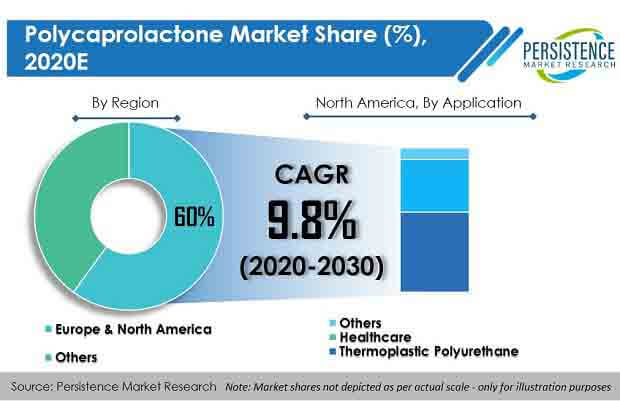Polycaprolactone Market Segmented By Pellets, Nano sphere, Microsphere Form with Ring Opening Polymerization, Polycondensation Of Carboxylic Acid Manufacturing Process in Thermoplastic Polyurethane, Healthcare
Industry: Chemicals and Materials
Published Date: August-2020
Format: PPT*, PDF, EXCEL
Delivery Timelines: Contact Sales
Number of Pages: 300
Report ID: PMRREP4522
Polycaprolactone (PCL) is a fossil-based, semi-crystalline, and biodegradable polyester with the molecular formula (C6H10O2)n. Its molecular weight and crystallinity are inversely proportional to each other, i.e. its crystallinity tends to decrease with any increase in its molecular weight. On exposure to moisture, heat, and microorganisms, PCL can naturally break down into organic components.
Some of the exceptional properties of polycaprolactone include better biocompatibility, biodegradability, non-toxicity, low viscosity, and its capability to easily melt, among others. PLC is derived from the chemical synthesis of crude oil, and can be degraded by aerobic and anaerobic microorganisms.
Various end users prefer polycaprolactone-based products as an effective solution for different healthcare applications. There has been considerable increase in the usage of biodegradable polyesters for the formulation of thermoplastic polyurethane.
Polycaprolactone-based polyurethanes are widely used in coatings, adhesives, sealants, and elastomers. These factors will continue to aid the expansion of the global polycaprolactone market size over the coming years.
Numerous factors are linked with the growth of the polycaprolactone market. Polycaprolactone is one of the highly attractive compounds in the category of biodegradable polyesters. Polycaprolactone is used in the formulation of thermoplastic polyurethane, which is further used in different end-user industries.
The main reason behind the adoption of polycprolactone as a raw material in the synthesis of thermoplastic polyurethane is its exceptional properties such as better hydrophobic characteristics, resistance to oil & grease, wear resistance, chemical resistance, UV-resistance, gloss, adhesion, and low temperature flexibility.
Also, the biodegradable nature of polycaprolactone promotes its adoption in numerous applications related to the healthcare industry, such as implants, orthopedic, drug delivery, wound dressing, etc.
Furthermore, increasing approvals by various regulatory bodies for the usage of polycaprolactone in the healthcare industry are expected to drive the growth of the polycaprolactone market.

From a regional perspective, Europe and North America are expected to remain dominant regions as far as polycaprolactone market share is concerned, throughout the forecast period of 2020 and 2030. Collectively, these two regions will entertain a market value share close to 60%.
Of the various countries in South East Asia, India is expected to witness the highest growth China holds maximum market share in terms of both, production and consumption. On the other hand, Latin America and MEA are projected to remain low volume – high growth regions in the global polycaprolactone market over the forecast period.
The COVID-19 outbreak has impacted almost all countries and economies around the world, including the functioning of the global polycaprolactone market space. The demand for polycaprolactone in TPU applications has been significantly impacted by the ongoing COVID-19 crisis, and will go on to dent market growth in the short term.
As the virus spread gets contained and industries open up slowly, the polycaprolactone market will gradually get back to its original growth rate. However, the timing and rate of revival will largely depend on the virus spread and the related containment measures implemented by authorities across the world.
As per PMR analysis, the global polycaprolactone market will experience an impressive CAGR of around 10% over the next ten years. Europe and North America are regions that will offer stakeholders in this space the most lucrative opportunities over the coming years. Application of polycaprolactone in thermoplastic polyurethane application will be the highest through 2030.
PMR’s study on the polycaprolactone market is divided into four significant segments – form, production method, application, and region. This report offers comprehensive data and information about the important market dynamics and growth parameters related to these categories, for the better understanding of readers.
| Attribute | Details |
|---|---|
|
Form |
|
|
Production Method |
|
|
Application |
|
|
Region |
|
To know more about delivery timeline for this report Contact Sales
